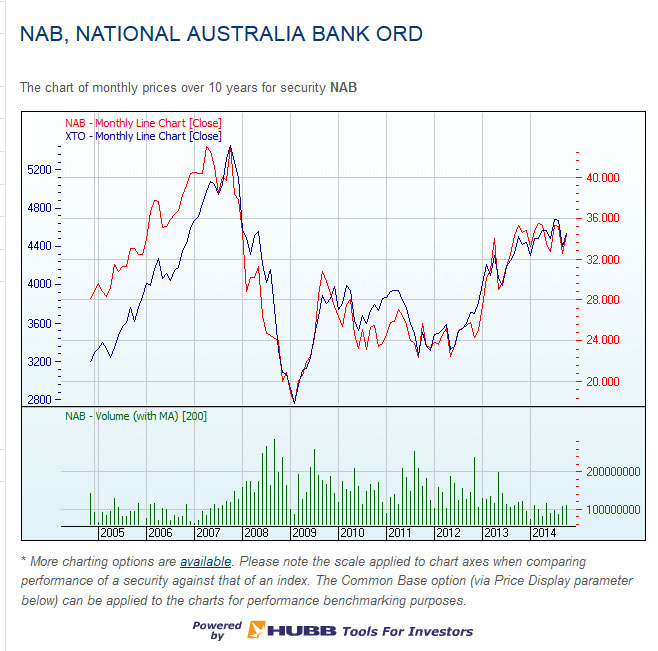Nab released full year results to September 2014 today. From the ASX announcement we see:
Cash earnings declined to $5.18 billion, which is 9.8% below the September 2013 full year due to earnings adjustments announced on 9 October 2014 relating to UK conduct provisions, capitalised software impairment, deferred tax asset provisions and R&D tax policy change totalling $1.5 billion after tax for the 30 September 2014 full year.
Excluding the impact of changes in foreign exchange rates, actual revenue declined 1.1%. After exchange rate adjustments, revenue increased by approximately 1.9% with higher lending balances, partly offset by a lower net interest margin (NIM) and weaker Markets and Treasury income.
Expenses rose 0.7 % excluding the impact of changes in foreign exchange rates and one-off adjustments. Adding in the impact of higher UK conduct provisions, capitalised software impairment and R&D tax policy change expenses rose 21%. Excluding these items and prior period UK conduct charges relating to PPI and IRHP, expenses rose 4.5% over the year.
Improved asset quality and deliberate portfolio choices made over recent years have resulted in a total charge to provide for bad and doubtful debts (B&DDs) for the year of $877 million, down 54.7% on 30 September 2013 due primarily to lower charges in Australian Banking and NAB UK CRE (Corporate Real Estate). The charge includes a $50 million release from the Group economic cycle adjustment and $99 million release from the NAB UK CRE overlay
The Group maintains a well diversified funding profile and has raised approximately $28.2 billion of term wholesale funding (including $7 billion secured funding) in the 2014 financial year. The weighted average term to maturity of the funds raised by the Group over the 2014 financial year was 5.1 years. The stable funding index was 90.4% at 30 September 2014, a 1.2 percentage point increase on 30 September 2013.
The Group’s Basel III Common Equity Tier 1 (CET1) ratio was 8.63 % as at 30 September 2014, an increase of 20 basis points from 30 September 2013 and broadly stable compared to 31 March 2014. As announced in the March 2014 half year results, the Group will target a CET1 ratio of 8.75% – 9.25% from 1 January 2016, based on current regulatory requirements.
The final dividend has been maintained at 99 cents, fully franked, and a dividend reinvestment plan (DRP) discount of 1.5% will be offered with no participation limit. NAB has entered into an agreement to have the DRP on the final dividend partially underwritten to an amount of $800 million over and above the expected participation in the DRP. Assuming a DRP participation rate of 35%, these initiatives will provide an expected increase in share capital of approximately $1.6 billion, which is equivalent to a 44 basis point increase in NAB’s CET1 ratio.
DFA believes the challenge for the bank is to get their Australian franchise to fire consistently, leveraging their footprint in home lending, business banking and wealth management. This will be a long and hard journey because it will be a question of excellence in execution, effective customer segmentation, and the removal of toxic customer servicing experiences, enabled by continued technology investment. We would also expect to see a continued withdrawal from the overseas ventures, which consistently underperformed. Overall, we believe NAB will become ever more reliant on the local Australian and New Zealand businesses, and that the long winding road of offshore investments will lead to further divestments. The truth is that the big four have a natural advantage in their home markets (high margins, benign competition and gentle regulation) and Australian banks find it very hard to perform consistently in the high-competition markets of the UK and USA. But Nab will have to work hard to break the cultural, process and systems barriers which beset the bank.
Finally, a release in provisions made a significant positive contribution this time around, but will not always be available.

